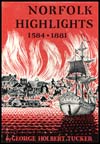Chapter 3
Whence Elizabeth River, Willoughby, and Two Points
The river that connects Norfolk with Hampton Roads, and three of the city's best-known geographical areas, have names that date from the first years of the Seventeenth Century.
These are the Elizabeth River, Willoughby, Sewells Point, and Lamberts Point, the last three having derived their names from prominent early Norfolk area settlers.
The Elizabeth River was named for the Princess Elizabeth Stuart (1596-1660), the daughter of King James I of England and a sister of Prince Henry Stuart and Prince Charles Stuart, later King Charles I, for whom the first Jamestown colonists named the two capes that guard the entrance to the Chesapeake Bay.
Elizabeth City County, originally known by the "the savage name of Kiccowtan," from which Lower Norfolk County was carved in 1637, was also named for her.
Willoughby takes its name from Captain Thomas Willoughby, who arrived in Virginia in 1610 at the age of nine as a passenger on the ship Prosperous.
Once he got a foothold in the New World, Willoughby's rise was rapid. And he was, successively, a justice of the peace, a member of the Assembly at Jamestown, and a member of the Governor's Council. He died in 1658 during a visit to England.
It is a matter of record that he owned a large tract of land embracing the present Willoughby area before 1626, and by 1635 he had built his family "manor house" there. This stood somewhere to the north of the present Ocean View Elementary School near the spot then known as "Willoughby's Point."
What is now known as Willoughby Spit, however, dates from the middle years of the Eighteenth Century. Even during the lifetime of Captain Thomas Willoughby, a series of underwater shoals formed over the years by the action of the waters of Hampton Roads and Chesapeake Bay existed west of the Willoughby manor plantation. Then, quite suddenly, in October of 1749, the Norfolk area was visited by a terrific tropical hurricane that did considerable crop and property damage and destroyed Fort George, which stood on the present site of Fort Monroe.
The accumulated sand churned up by this storm caused the shoals adjacent to the Willoughby plantation to surface. And from then on the long curved finger of sand continued to build up until it became known by its present name, Willoughby Spit.
Sewells Point, a corruption of "Mr. Seawell's Pointe," takes its name from Henry Seawell, who had settled by 1629 in Elizabeth City County, from which Lower Norfolk County was carved in 1637.
According to the record, Henry Seawell the elder did "cleare, seate, build, and plant" on one hundred and fifty acres of the tract later known by his name shortly after December of 1633.
With his neighbor, Captain Thomas Willoughby, Seawell was among the Virginia executors of Captain Adam Thorowgood, the leading Norfolk area citizen of his day, when the latter died in 1640.
Between 1638 and 1640, the first parish church of Lower Norfolk County, the mother church of the Episcopal Church in the Norfolk area, was built on Sewells Point somewhere on the site of the present Norfolk Naval Station. And when Seawell and his wife died in the early 1640s, they were buried in its chancel.
Lamberts Point, now the site of one of the busiest coal export facilities in the world, was named for Thomas Lambert, who patented one hundred acres there on the east side of the "Bay" of Elizabeth River on June 1, 1635, when the territory was still a part of Elizabeth City County.
Lambert was an ensign in the Lower Norfolk County Militia by 1640 and was later a major in the same outfit. He was later a member of the Assembly at Jamestown for Lower Norfolk County in 1652, and by the time of his death in 1671 he was the proud bearer of the title Lieutenant Colonel Thomas Lambert.
Chapter 4
The Origin of Norfolk's Name
Norfolk Highlights 1584 - 1881

See the "Table of Contents" for links to every chapter in Norfolk Highlights 1584 - 1881 by George Holbert Tucker.
